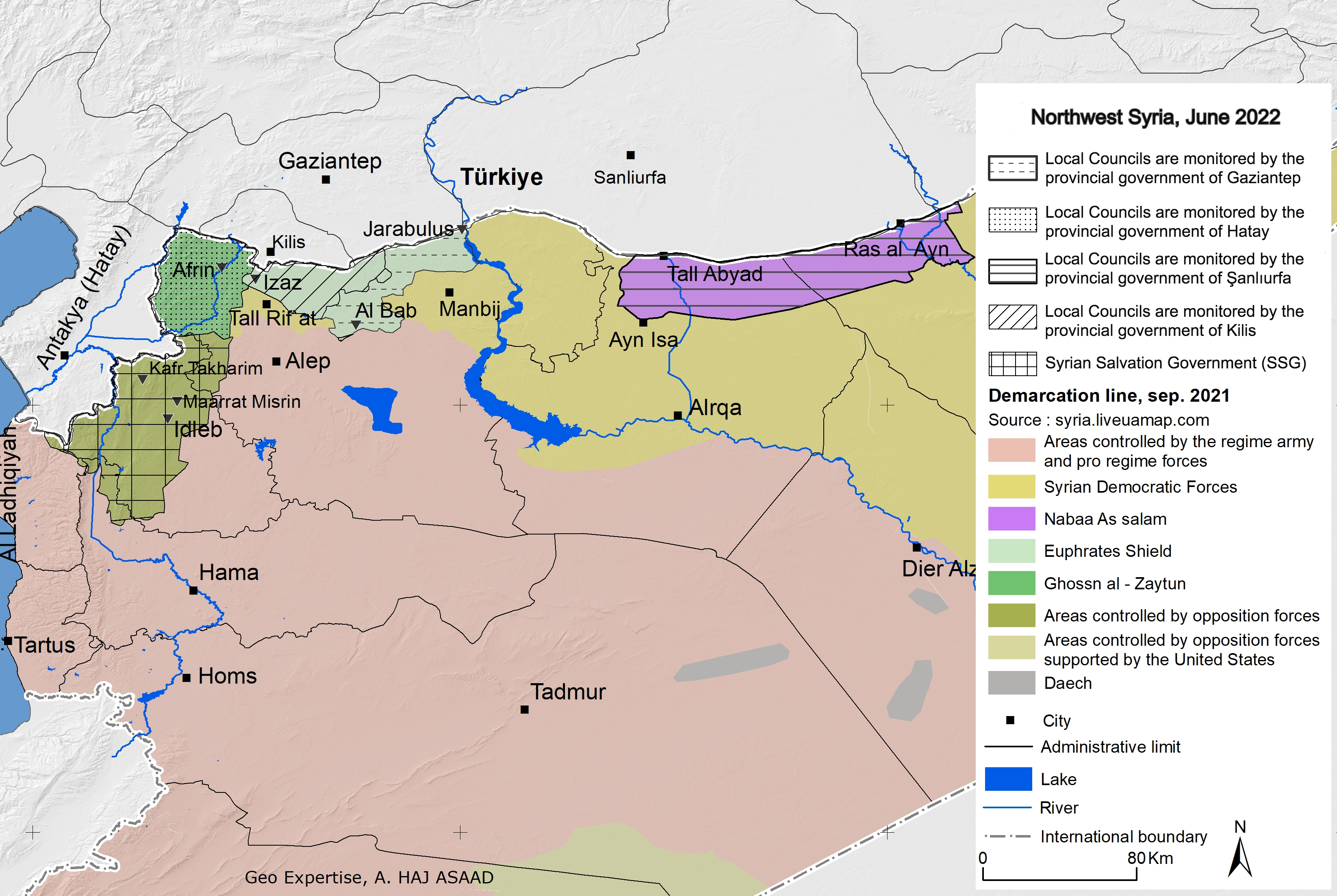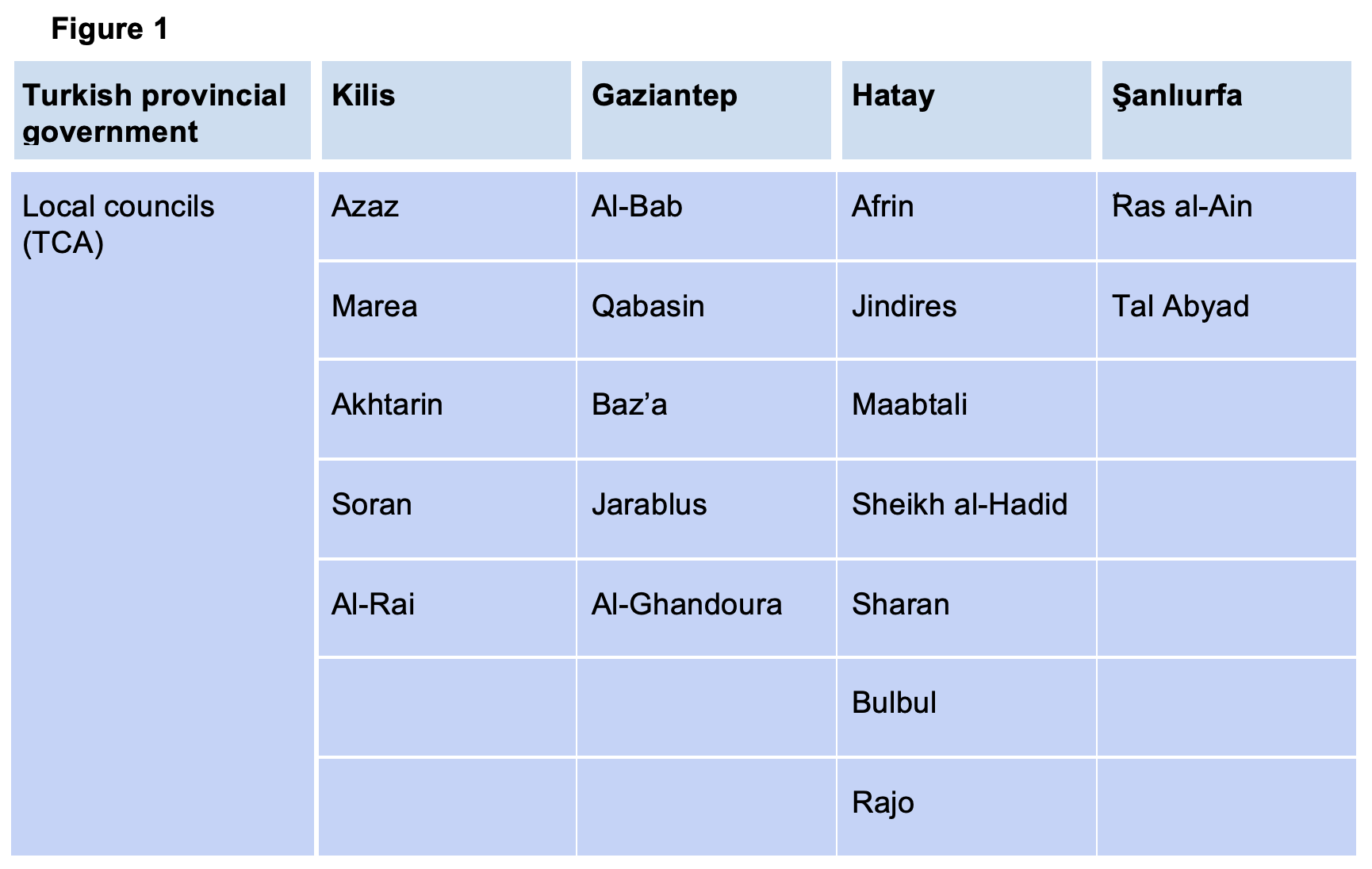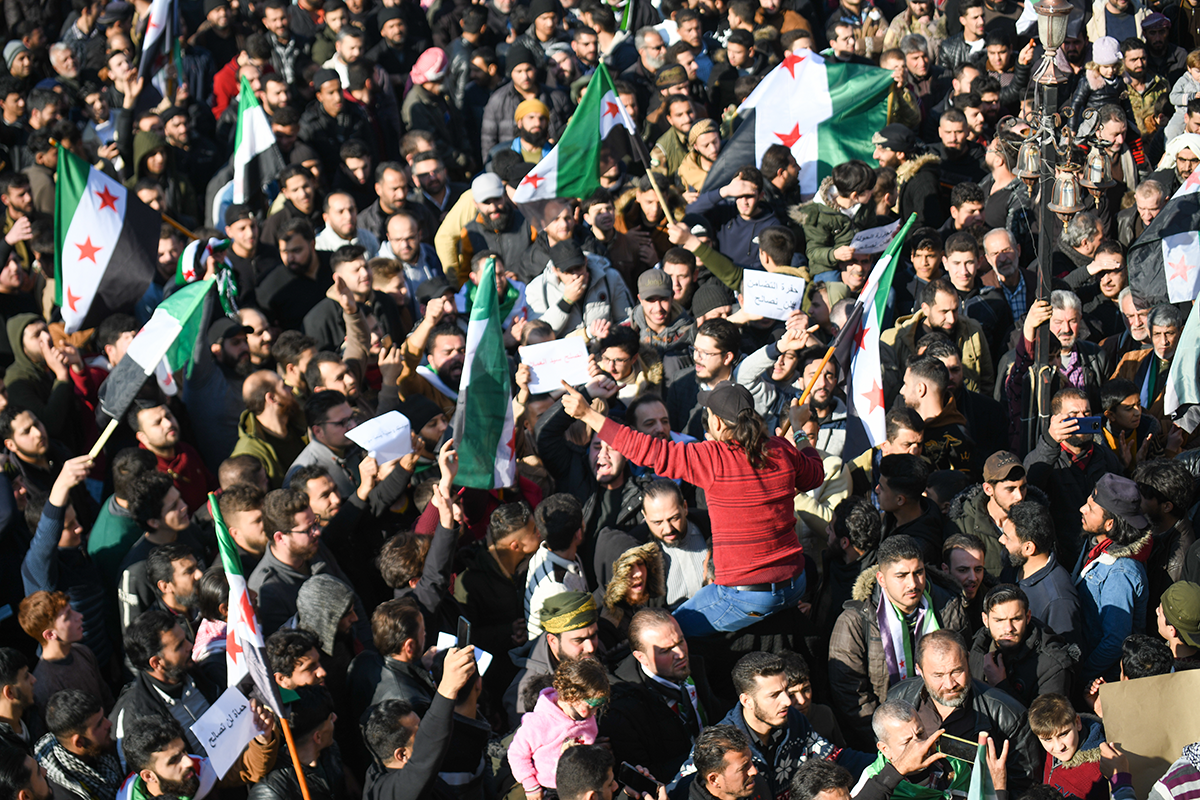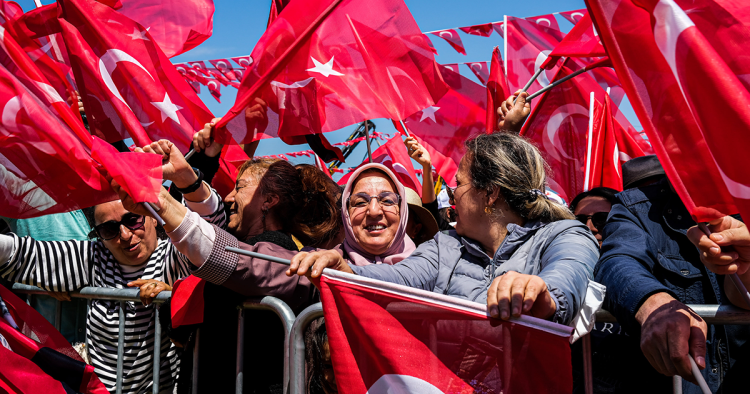Introduction
In mid-March 2023, amid the widespread destruction caused by the Feb. 6 earthquake in southern Turkey, President Recep Tayyip Erdoğan declared that the country’s presidential and parliamentary elections would take place on May 14, notwithstanding the ongoing recovery efforts. Erdoğan announced his intention to run for another term as president nearly a year ago, in June 2022, and entreated Kemal Kılıçdaroğlu, the leader of the main opposition Republican People’s Party (CHP), to follow suit. Kılıçdaroğlu held off for another nine months, only announcing his candidacy in March 2023 after extended discussions and negotiations with the so-called “Table of Six” (Altılı Masa) opposition alliance, established in 2022 to challenge Erdoğan.
Over the past year, Erdoğan has repeatedly expressed his intention to conduct a new military operation in northern Syria — in what would be Turkey’s fifth such operation since 2016 — to secure the Syrian-Turkish border. The previous military operations allowed Turkey to establish control over part of Northwest (NW) Syria and to limit the area under the control of Kurdish forces. The Syrian conflict has had a major impact on Turkey’s internal political discourse, with much of the discussion centering around the conflict itself, Turkey’s role in northern Syria, and the refugee crisis. However, a few months ago Erdoğan began to suggest that he might adopt a new approach toward Syria and meet with Syrian President Bashar al-Assad after nearly a decade of estrangement.
NW Syria has become the final bastion for the opposition to the Syrian regime, encompassing armed factions, radical Islamist groups, and civilians who have taken refuge there. The massive earthquake on Feb. 6, 2023, put both countries in the spotlight once again, drawing attention to the long-standing conflict in Syria, particularly in the NW, which has seen vast swathes of the region destroyed by war and millions of people displaced as refugees. The earthquake has only served to compound the devastation.
Methodology
This paper employs a scenario analysis methodology to explore potential outcomes that may impact NW Syria following the upcoming Turkish presidential and parliamentary elections on May 14. The paper draws upon electoral programs, statements, and evolving stances toward the Syria issue to inform its analysis. Although the Kurdish factor holds a significant place in Turkey’s Syria policy, this analysis primarily addresses the regions of Idlib and the Turkish-Controlled Areas (TCA) and concentrates on potential post-election policy changes.
This paper focuses on the two leading candidates in the Turkish presidential elections, namely President Erdoğan of the ruling People’s Alliance and CHP leader Kılıçdaroğlu of the opposition bloc Nation Alliance. There are, however, two other candidates running as well, Muharrem İnce of the Homeland Party and Sinan Oğan of the far-right ATA Alliance, both of whom are polling in the single digits.
Turkey’s Evolving Role in Northwest Syria: From Overthrowing the Regime to Border Security
NW Syria, comprising the regions of Idlib and west Aleppo, as well as limited parts of Latakia and Hama governorates, is presently the final bastion1 for the Syrian opposition and extremist groups, with a population of more than 4.5 million people. Turkey has played a critical role in the region and has been involved in the conflict from the outset. At first, Turkey endeavored to depose the Assad regime during the initial stages of the uprising, a pursuit that continued until the latter part of 2014. This was then followed by a new policy, focused on eradicating the Islamic State (ISIS). Finally, Turkey’s main policy when it comes to Syria has been to prevent the establishment of a Kurdish state in northern Syria, which has been the basis for all its deliberations, electoral campaigns, and military operations. Despite its efforts to ward off Kurdish armed groups, Turkey has been unable to halt the formation of an independent administration by the Kurds in Northeast (NE) Syria. Ankara carried out four military operations between August 2016 and March 2020 in northern Syria, where it has stationed its troops in Idlib and west Aleppo and established a governance system in the TCA.

The Turkish-Controlled Areas
In the wake of Turkey’s military incursions into Syria, a new order was imposed upon the region after 2016 under the aegis of the Turkish authorities and military. These new conditions had far-reaching consequences for security, providing backing for diverse militant factions, and effectively serving as the headquarters for the Free Syrian Army (FSA), later renamed as the Syrian National Army (SNA) in 2017. In this capacity, Turkey offered training, support, and salaries, exerting a considerable impact on the army. Furthermore, Turkey sought to lay the groundwork for administration and governance in the affected regions by establishing civil institutions, local councils, and services such as education, health, infrastructure, and energy.2 Regulations and directives stemming from Turkish provincial governments carried weight, with duties allocated to border provincial governments like Gaziantep, Hatay, Kilis, and Şanlıurfa (see Figure 1 below), to supervise the administration of particular cities and villages in the TCA.

Idlib
During the period between February and March 2020, Operation Spring Shield brought about the creation of new boundaries3 in the Idlib area that would be defended by radical anti-Assad groups. Turkey dispatched troops and armed factions to the area, erecting checkpoints along the border with the Syrian regime. In contrast to previous instances, Turkey did not involve itself in the governance of Idlib, restricting its role to a military presence.
Since 2017, the Idlib area has been primarily governed by the Syrian Salvation Government (SSG), which serves as the civil and administrative arm of Hay’at Tahrir al-Sham (HTS), the most potent Islamist armed group. Local councils established since 2012 in NW Syria have seen their role reduced with the emergence of HTS’s new civil entities. Despite being designated as a terrorist group, HTS has attempted to revamp its image internationally in recent years.
Apart from controlling the Bab al-Hawa border crossing, the SSG also provides and regulates services in the area. Turkey contributes to these services through the private sector, such as Turkish or Syrian-Turkish companies that provide electricity or subsidized fuel products. Non-profit organizations also play a role in sectors such as water, education, and health.
During a meeting with residents and internally displaced persons in Idlib governorate earlier this year, the HTS commander-in-chief, Abu Muhammad al-Jolani, expressed apprehension about Turkey’s negotiations with the Syrian regime, saying that they imperiled the principles of the Syrian revolution. He underscored the need to push back against normalization without making new enemies, acknowledging that it would be a challenging era. According to Jolani, this shift in Turkey’s stance toward the Syrian conflict can be attributed to changes in its Syria policy since 2015 and the Russian intervention, as well as the upcoming Turkish elections.
It is evident that Turkey wields significant influence in most sectors of the TCA, and its role in Idlib is crucial. Furthermore, there is a pervasive sense of apprehension4 in NW Syria, with the populace and various armed groups fearing a complete shift in Turkish policy toward the region.
Recently, a multitude of Syrians have taken to the streets in NW Syria to protest the possibility of a reconciliation between the Assad regime and the Turkish administration. They have loudly and clearly voiced their opposition, chanting slogans that reject any such agreement. As of the present writing, the prospects for reconciliation remain uncertain.

A New Approach to Syria? Examining the Turkish Opposition’s Program
In Turkey’s 2019 local elections, the opposition displayed their political acumen by successfully challenging and defeating the ruling Justice and Development Party (AKP), winning resounding victories in major cities like Istanbul, Ankara, and Izmir. On Jan. 30 of this year, the Nation Alliance issued its comprehensive electoral manifesto, totaling 242 pages and broken down into three primary sections: the rule of law, economic crisis, and foreign policy. While the Nation Alliance has put forward a detailed plan for domestic affairs, its foreign policy program is occasionally incongruous. On the one hand, the program emphasizes adherence to international law and universal values, as well as the goal of joining the European Union and adopting its norms and values. On the other hand, the program advocates for normalizing relations with the Syrian regime, calling for the return of refugees, restricting citizenship grants, and revoking citizenship in specific cases. Additionally, the program outlines stricter border controls to prevent new refugees from entering Turkey.
Despite apparent differences among the six parties that make up the Nation Alliance regarding foreign policy5 and the Syrian conflict, the electoral manifesto reflects a number of shared positions on issues related to Syria, including the “Syrian Government,” Syrian refugees, the fight against terrorism, and post-conflict reconstruction efforts in Syria. Adopting the traditional Kemalist foreign policy doctrine of “Peace at home, peace in the world,” the Nation Alliance has outlined several points regarding the Syrian crisis, expressing a commitment to respecting the territorial integrity and sovereignty of neighboring countries and declaring its intent to pursue peaceful, diplomatic solutions to any disputes that arise. Thus, if they are successful in the upcoming elections, they plan to withdraw from NW Syria. The opposition views the Assad regime and its government as a potential partner for future cooperation and has proposed initiating discussions with the Syrian government and other regional stakeholders, excluding “terrorist organizations,” to resolve the Syrian conflict in accordance with U.N. resolutions.
Opposition presidential candidate Kılıçdaroğlu has also stated that Syrian refugees will be repatriated to their homes within two years. The opposition has secured the initial support of the pro-Kurdish Democratic Peoples’ Party (HDP), which advocates for the complete withdrawal of Turkish forces from NW Syria. This alignment could further motivate the opposition to pursue these proposed policies. However, the opposition’s electoral manifesto lacks a well-defined approach regarding planned talks with the Syrian regime and the withdrawal from NW Syria, with their campaign primarily focusing on refugee repatriation and border protection. Nonetheless, a swift and significant change in Turkish policy toward Syria is expected in the event of Kılıçdaroğlu’s victory in the upcoming May elections.
The above discussion has focused on examining the possible outcomes for NW Syria after the Turkish elections. The next sections will delve into the various potential scenarios depending on who wins the elections: a stable status quo, a partial withdrawal, or a full withdrawal.
The Impact of the Turkish Elections on Northwest Syria: Three Potential Scenarios
In the first scenario a stable status quo continues to prevail in NW Syria. The likelihood of this outcome is greater if Erdoğan retains his grip on power, even if he fails to maintain a majority in parliament. In this case, Erdoğan might deviate from his course of normalization with the Assad regime after he successfully consolidates power for an additional five years. Consequently, Turkish forces would remain in NW Syria and the Erdoğan administration would continue to exert a significant influence in the region. In Idlib, HTS would remain the principal agent with little external contact other than, to a limited extent, with the Turkish authorities. The SSG would strive to strengthen its governance and create the appearance of stability in Idlib. The TCA would remain relatively unchanged unless Ankara scrutinizes the situation, especially after the earthquake, regarding the efficacy of governance implemented by the Turkish authorities. Additionally, Turkey would maintain its influence over the SNA and continue to provide various services to the region. Given Erdoğan’s continued reliance on a security approach to the Syrian conflict, he might threaten a new military intervention in northern Syria. To summarize, in this scenario the situation in NW Syria would likely remain comparatively static due to the stable Turkish administration.
In the absence of any force majeure that compels the Turkish opposition to retain its military presence and governance model in NW Syria, there is no indication that the region would enjoy any rest should the opposition win in the May elections. People in NW Syria are currently in a severe state of anxiety, as they hear news from their fellow Syrian refugees in Turkey and the statements made by various opposition figures and the presidential candidate himself.
In the second potential scenario the Turkish administration, regardless of its leader, opts to undertake a partial withdrawal from NW Syria, primarily concentrating on administration rather than its military presence. This would be achievable if the Turkish leadership decides to modify its governance approach to the TCA. In this case, it would aim to reduce Turkish involvement in daily governance in NW Syria, with a focus on stabilizing the region and reducing the responsibilities of the border provincial governments. The Turkish authorities would maintain a diplomatic relationship with the Assad regime, potentially under the auspices of Russia or Iran, while impeding the reassertion of control over the region by Assad and Russia.
Erdoğan, for example, would perceive this as a triumph on various fronts, as he would challenge the international community by contending that the Turkish armed forces in NW Syria protect the nation’s borders and security. He would declare to his people that he seeks a resolution of the refugee crisis in Turkey. Under this scenario, Erdoğan may strive to initiate communication and coordination with the most potent group or a new coalition formed with Turkey’s assistance, whereby HTS would aim to rebrand itself further. As a result, the governance model of the SSG, with its centralized structure, would expand to encompass the TCA. However, the Turkish forces would continue to remain stationed in NW Syria, and the security situation in the region would remain largely unaltered. Nevertheless, in terms of governance, Turkey would seek to institute a single model and aim to achieve maximum stability in the region. The role of local councils might wane in favor of the SSG or the new administration, and the Turkish border provincial governments would no longer be responsible for the various areas in NW Syria. Turkey would continue to provide assistance in delivering services and sustaining the trade relationship with the region, deeming it a buffer zone while awaiting another opportunity for a complete withdrawal.
Even if the opposition wins the presidency, they will be forced to deal with the reality of the Turkish role in NW Syria and the possibility of renewed conflict and subsequent waves of refugees, likely prompting them to refrain from enacting their campaign promises. The opposition plans to withdraw partially from Syria due to the security situation and to stabilize the region while securing the border areas, enabling it to implement one of its most important campaign promises, the return of refugees. The new Turkish administration would maintain a relationship with the armed groups in NW Syria and aim to increase the influence of the less radical groups. At the same time, they would maintain a relationship with the Syrian regime and their troops would act more like peacekeeping forces, potentially calling on other Arab or regional forces to join the Turkish ones in NW Syria. The U.S. could potentially intervene indirectly to pool efforts between the actors in the NE and NW to protect the region from additional attacks by Assad and Russia.
In the third hypothetical scenario, the Turkish opposition, having won the elections, would prioritize fulfilling the pledges it made to the Turkish public and not act on Western recommendations about its Syria policy. The new administration would initiate the construction of a separation wall along the Syria border, withdraw the Turkish military from NW Syria, and end its support for the SNA. This would render the name of the TCA obsolete and jeopardize the governance model previously implemented in the region. Although the inner circle around the incumbent administration does not see this as a feasible option for Erdoğan, such a scenario is plausible in the near future.
In the event that the next president, whether it is Kılıçdaroğlu or Erdoğan, moves ahead with full normalization with Assad and begins to withdraw Turkish forces from Syria, what could potentially be the outcome?
In such a scenario, armed groups in NW Syria would face a difficult decision. They would have to choose whether to engage in battle against the Syrian regime and its ally Russia, despite losing their primary supporter and facing the likelihood of severed supply routes. Alternatively, they could reconcile with the regime under the guarantee of Turkey or another mediator, as has happened in the past between the Syrian regime and the opposition, when tens of thousands of people and fighters left for Idlib after the regime regained control of Aleppo.
The current situation in NW is different as there is no other place for them to go, and the people do not wish to live under the Assad regime again. In addition, the previous reconciliation experiences with the regime or the return of refugees do not seem like good options for either the people or the fighters. The latter would likely take up arms against their attackers and might be joined by new and former fighters, potentially resulting in a force of more than 70,000 between Idlib and the Aleppo countryside. This situation could prompt large-scale flight from the region, with Turkey being the primary destination. Turkey could potentially see millions of people on its borders, leading Syrians in Turkey to face significant pressure from Turkish politicians and the public, prompting them to seek refuge elsewhere, mainly in Europe. It is unclear how the armed groups, especially the radical ones, would respond to the Turkish administration in this scenario. The armed groups in the Kurdish areas might attempt to reclaim what was taken from them by Turkey in its previous military operations.

Navigating the Challenges and Opportunities of a Critical Era
The situation in NW Syria presents both challenges and opportunities for the international community. One of the key challenges is to ensure the safety and security of Syrian refugees and the millions of people in NW Syria, which has been neglected in the past. Addressing this challenge presents an opportunity for the international community to collaborate with the new Turkish administration after the elections to develop strategies that safeguard both Turkey’s security and the Syrians living in Turkey and NW Syria.
Another challenge is the potential for a new conflict in Syria, which could result in another disaster and a new wave of refugees. However, this situation also offers an opportunity for the United States, the European Union, and the United Nations to collaborate to prevent such a scenario from unfolding and promote a peaceful resolution.
Furthermore, the different armed groups in NW Syria face the challenge of working together to confront various scenarios that may arise. However, once again this also presents an opportunity to coordinate efforts and prioritize the well-being of the local population. Establishing communication between the NW and NE regions can further promote stability and ensure the safety of those living in both regions. The success of these efforts depends on the cooperation and collective action of all parties involved.
Conclusion
The Turkish elections are expected to be a critical turning point in the country’s history and could have a significant impact on the future of Syria, and especially the NW, where the Turkish authorities hold considerable sway. The Syrian conflict and its aftermath, including the presence of Turkish forces in NW Syria, the refugee crisis, and the possibility of normalization with the Syrian regime, are hotly debated topics in Turkey and are often used by the opposition to criticize the current government. President Erdoğan has attempted to regain control of the narrative surrounding the Syrian conflict by indicating his willingness to engage in talks with Assad. However, during Assad’s recent trip to Russia in March 2023, he made several demands for resolving the dispute, including the withdrawal of Turkish troops from NW Syria. Although a meeting between the two leaders was planned, it has been postponed, and it is unlikely that any such meeting will occur before the May 14 elections.
In the event that Kılıçdaroğlu wins, will the opposition carry out its promises and pursue a complete reversal of Turkey’s Syria policy? Or would he seek amicable relations with the EU and uphold the principles of international law, even as he collaborates with the Assad regime to compel millions of refugees to return to Syria? Will Erdoğan stick to his newfound path of reconciliation with his former foe Assad or will he reconsider his approach to the Syrian predicament? What about the armed groups in NW Syria, the framework of governance, and the relationship between the NW and NE Syria? How will the international community respond in the event of a potential new conflict in Syria, and what action will Turkey take in the face of new security threats? All these questions might be resolved after May 14 after Turkish voters head to the polls.
Irrespective of the outcome of the forthcoming Turkish elections, there are several potential scenarios for Turkey’s approach to the situation in NW Syria. The first scenario entails maintaining the current stable status quo in the region, whereby the new government is unlikely to introduce any major changes. The second scenario would see a partial withdrawal, particularly in terms of governance, where Turkey may encourage the formation of a single governing body for NW Syria. The third potential scenario entails a complete policy shift, whereby Turkey is anticipated to persist in its efforts to improve relations with the Syrian regime, regardless of the government’s political orientation. This would bring an end to the decade-long dispute and have significant implications for security, governance, economy, and armed groups in NW Syria.
As the Turkish election draws near, the future of Ankara’s relationship with NW Syria hangs in the balance. The possibility of a total policy shift toward normalization with the Assad regime raises concerns for those who have suffered under his rule. Meanwhile, the residents of NW Syria continue to be forgotten, caught in the middle of a conflict that has left them without even basic necessities. These individuals are anxiously waiting and watching to see how the Turkish elections play out, apprehensive about a potential turning point after May 14, 2023.
Fares Halabi is a policy expert and researcher with a focus on the MENA region, particularly Syria. His areas of expertise include governance, elections, human rights, and disinformation.
Photo by Murat Kocabas/SOPA Images/LightRocket via Getty Images
Endnotes
- Anti-Assad and non-Kurdish forces, while the People’s Protection Units (YPG) and Syrian Democratic Forces (SDF) control the northeastern part of Syria.
- Through Turkish-Syrian and private companies, with local councils taking responsibility.
- With the Syrian regime.
- Interviews between January and March with Syrians based in NW & NE Syria and in Turkey.
- Since the onset of the Syrian War, the CHP has been steadfast in its support for President Bashar al-Assad. Reports indicate that the Felicity Party (SP) shares a similar stance on this issue. In contrast, the remaining members of the Nation Alliance have not taken a clear position on this matter despite persistent inquiries. This holds true for their response to the ongoing conflict between Russia and Ukraine as well.
The Middle East Institute (MEI) is an independent, non-partisan, non-for-profit, educational organization. It does not engage in advocacy and its scholars’ opinions are their own. MEI welcomes financial donations, but retains sole editorial control over its work and its publications reflect only the authors’ views. For a listing of MEI donors, please click here.













